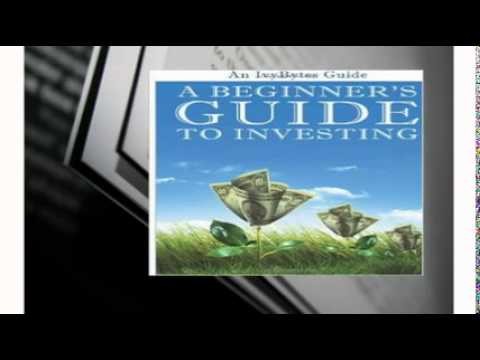A Beginner s Guide To Investing
Post on: 6 Апрель, 2015 No Comment

By on Tuesday, January 1st, 2013 | No Comments
Welcome to the world of investing. This is the place that you can put your money to work for you. Believe it or not, people discovered thousands of years ago that there was a way to avoid all the backbreaking labor that typifies many working lives.
By using your money wisely and exerting certain principles such as patience, self-restraint and a dash of daring, you can lead a relatively leisurely life after creating multiple and reliable income streams. All it takes to get started is a little knowledge of vocabulary and the willingness to heed some basic wisdom about this endeavor.
The Basics on Financial Instruments
A financial instrument is anything of value which can be traded. For the purposes of this lesson in investment, any of the tradable assets available on the stock market will be classed as financial instruments, though that term may only loosely apply when strict definitions are used. Each of the major classes of financial instruments is explained below.
For the most part, each of them is available for the investing public without any prerequisites. However, trading profitably in some of these assets may require more experience than others.
These are the most popular and well-known form of investing. Novices may mistakenly think that these are the only financial instruments available.
A stock is a share in a publicly-traded company. Eventually, after a company has had enough success to convince its owner or owners that such a move would be in the best interest of everyone involved, a business may sell shares of its ownership to the public.
During this initial public offering, the shares sell and their profits go to the owner or owners. After that, the shares may be sold freely among members of the public for varying prices that depend largely on public perception of the companys fortunes.
When you buy stocks, you literally gain ownership in the company which they represent. That ownership may not amount to much if you only own a few thousand shares or less, but it is real nonetheless. Many companies sell millions of shares that each represent very little of the total.
Many stocks issue dividends. These are favorites among smart investors. Every so often, the boards of directors for these companies convene and determine how much their companies have made in profits over a given period. The boards then determine how much to reinvest in the company and how much to distribute to shareholders.
Shareholders generally receive portions of the profits in proportion to the number of shares that they hold. Each company determines how often it will meet to do this. Some do it quarterly while others do it on an annual basis.
Companies are not required to apportion profits and, if there are no profits due to financial setbacks, they may not give out any dividends at all. Successful companies make excellent stock targets for investors because they can turn dividends into income and enjoy a life less occupied by work.
Stocks sound so financially advantageous after that introduction that you might wonder why anybody does anything besides invest in stocks. Investing in stocks, though, is also dangerous. While you may make money on your investment, you can also lose money. In fact, it is possible to lose all the money that you put into a stock with no recourse whatsoever.
These risks cause some people to focus their investments more in the area of bonds. Bonds are distinct from stocks because they are not pieces of companies. They are, rather, pieces of debt.
A government or a large corporation issues bonds in an attempt to generate needed capital. These bonds are essentially loans. What may strike you as a reversal when you buy them is that you are the lender in this case.
When you buy a bond, you lend money to the issuer. The issuer of the bond agrees to pay you a yield, which is determined by the bonds interest rate, over the course of the bonds duration. Many times, a bonds maturity may be as far as 10 or even 30 years in the future.
Bonds have a very low yield when compared to the average stock investment. However, bonds are guaranteed by their backers and many investors prefer the certainty of a bond investment over the possibility of high gains in a stock. At the present, however, investors should note that there are rumors of a coming bond bubble which may shoot holes in this theory about the safeness of bond investing.
Both stocks and bonds worry some investors with their abstract nature. These investors often prefer to invest in commodities. Commodities are raw goods that are intended for consumption. These raw materials might be crops or they might be metals .
In general, they are things which grow or are extracted from the ground. They include specific items such as wheat, rubber, iron, oil and gold. Commodities are often the underlying investments for derivatives trading.
• Index Funds
Investing in single bonds, stocks and commodities has long been recognized as a dangerous practice. In certain cases of very dependable stocks it may work out well but you have to pay a lot of attention and devote a lot of time to research to get your investments right. That is why many people seek to diversify their investments by putting their money in index funds.
This is a whole class of investment schemes that includes things such as mutual funds. Each fund pools money from multiple investors and buys shares, bonds commodities and other assets with the money. The funds then sell shares. When you buy a single share in one of these funds, you are automatically invested in each of the underlying assets that the fund owns.
• Exchange-Traded Funds
These are known as ETFs. They are a form of index fund but they act a little differently. An ETF invests in underlying assets but it has some tax advantages over mutual funds. It is also easier to use because you can buy and sell shares in an ETF as if they were really stocks. With traditional mutual funds, you can only buy and sell shares once a day.

• Derivatives
These financial instruments are for the fearless and advanced trader. They depend on future values of assets, typically commodities. They have unique investing strategies that allow people to use loaned money and opt out of obligations if they appear disadvantageous.
Investment Guidelines
Keep in mind a few simple rules when you invest.
Never put all of your money into one investment, not even a mutual fund. In fact, the best strategy is to spread your money out very thinly. You should never really put more than a few percentage points of your total available funds in any investment.
If you start out small, you may not be able to do this. However, as your funds grow, your first goal should be to acquire varied financial instruments.
• Do Not Gamble
Never put more money into anything than you are willing to lose. This should keep you from overreacting to hot tips and investing all of your money into a single asset. Instead, practice restraint and limit the amount that you invest according to a self-imposed rule.
• Adjust Your Risks
When you are young, it makes sense to take more risks with certain investments because higher risk automatically entails the possibility of higher gains. Avoid bonds when you are young. However, as you grow older, you want to shift your holdings into more conservative investments in order to lock in the gains that you have achieved. Then you can rely on bonds to protect your earnings later in life.
• Reinvesting
It is tempting to take your earnings and have some fun. Instead, allow compounding to occur. As you receive dividends and bond yields spend as little as possible on yourself. Reinvest these earnings into other financial instruments to increase future earnings even more.
You can be financially independent if you follow these rules. Gain an understanding of the basics of investing and you will never regret putting your money to work.














